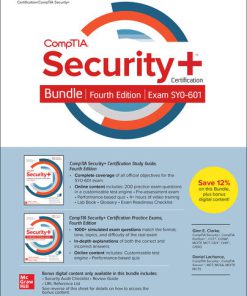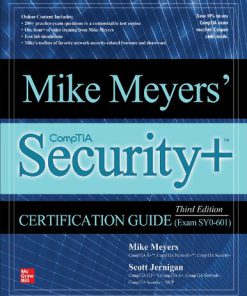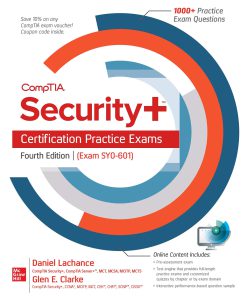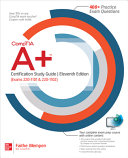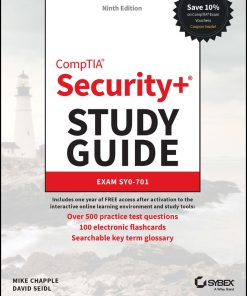CompTIA Security+ Certification Study Guide, Fourth Edition (Exam SY0-601) by Glen E. Clarke 9781260467949 1260467945
$50.00 Original price was: $50.00.$25.00Current price is: $25.00.
CompTIA Security+ Certification Study Guide, Fourth Edition (Exam SY0-601) Clarke – Ebook Instant Download/Delivery ISBN(s): 9781260467932,1260467937, 9781260467949 ,1260467945
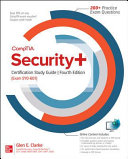
Product details:
- ISBN 10: 1260467945
- ISBN 13: 9781260467949
- Author: Glen E. Clarke
CompTIA Security+ Certification Study Guide, Fourth Edition (Exam SY0-601)
Table contents:
1 Networking Basics and Terminology
Understanding Network Devices and Cabling
Looking at Network Devices
Understanding Network Cabling
Exercise 1-1: Reviewing Networking Components
Understanding TCP/IP
Reviewing IP Addressing
Exercise 1-2: Understanding Valid Addresses
Understanding TCP/IP Protocols
Exercise 1-3: Viewing Protocol Information with Wireshark
Understanding Application Layer Protocols
Understanding IPv6
Exercise 1-4: Identifying Protocols in TCP/IP
Network Security Best Practices
Device Usage
Cable and Protocol Usage
Certification Summary
Two-Minute Drill
Q&A Self Test
Self Test Answers
2 Introduction to Security Terminology
Goals of Information Security
Confidentiality
Integrity
Availability
Accountability
Exercise 2-1: CIA Scenarios
Understanding Authentication and Authorization
Identification and Authentication
Authorization
Understanding Security Principles and Terminology
Types of Security
Least Privilege, Separation of Duties, and Rotation of Duties
Concept of Need to Know
Layered Security and Diversity of Defense
Due Care and Due Diligence
Vulnerability and Exploit
Threat Actors
Threat Vectors
Threat Intelligence Sources
Research Sources
Looking at Security Roles and Responsibilities
System Owner and Data Owner
Data Controller and Data Processor
System Administrator
User
Privileged User
Executive User
Data Roles and Responsibilities
Security Officer
Exercise 2-2: Security Terminology
Certification Summary
Two-Minute Drill
Q&A Self Test
Self Test Answers
3 Security Policies and Standards
Introduction to Security Policies
Structure of a Policy
Identifying Types of Policies
General Security Policies
Policies Affecting Users
Policies Affecting Personnel Management
Policies Affecting Administrators
Exercise 3-1: Reviewing a Security Policy
Policies Affecting Management
Other Popular Policies
Human Resources Policies
Hiring Policy
Termination Policy
Mandatory Vacations
Security-Related HR Policies
Exercise 3-2: Creating a Security Policy
User Education and Awareness
General Training and Role-Based Training
User Habits
New Threats and Security Trends
Use of Social Networks and P2P Programs
Training Metrics and Follow-Up
Exercise 3-3: Designing a Training Program
Importance of Policies to Organization Security
Privacy and Sensitive Data Concepts
Regulations and Standards
Regulations, Standards, and Legislation
Frameworks and Security Guides
Benchmark/Secure Configuration Guides
Certification Summary
Two-Minute Drill
Q&A Self Test
Self Test Answers
4 Types of Attacks
Understanding Social Engineering
Social Engineering Overview
Popular Social Engineering Attacks
Physical Attacks
Adversarial Artificial Intelligence
Supply-Chain Attacks
Cloud-Based vs. On-Premises Attacks
Reasons for Effectiveness
Preventing Social Engineering Attacks
Identifying Network Attacks
Popular Network Attacks
Exercise 4-1: DNS Poisoning After Exploit Using Kali Linux
Exercise 4-2: Performing a Port Scan
Other Network Attacks
Malicious Code or Script Execution
Preventing Network Attacks
Looking at Password Attacks
Types of Password Attacks
Cryptographic Attacks and Concepts
Online vs. Offline Attacks
Other Password Attack Terms
Preventing Password Attacks
Certification Summary
Two-Minute Drill
Q&A Self Test
Self Test Answers
5 Vulnerabilities and Threats
Security Concerns with Vulnerabilities
Reasons for Vulnerable Systems
Understanding the Impact of Vulnerabilities
Common Security Issues and Device Output
Exercise 5-1: Removable Media Control
Cloud-Based vs. On-Premises Vulnerabilities
Identifying Physical Threats
Snooping
Theft and Loss of Assets
Human Error
Sabotage
Looking at Malicious Software
Privilege Escalation
Viruses
Other Malicious Software
Protecting Against Malicious Software
Threats Against Hardware
BIOS Settings
USB Devices
Smart Phones and Tablets
Exercise 5-2: Exploiting a Bluetooth Device
Removable Storage
Network Attached Storage
PBX
Security Risks with Embedded and Specialized Systems
Certification Summary
Two-Minute Drill
Q&A Self Test
Self Test Answers
6 Mitigating Security Threats
Understanding Operating System Hardening
Uninstall Unnecessary Software
Disable Unnecessary Services
Exercise 6-1: Disabling the Remote Desktop Services Service
Protect Management Interfaces and Applications
Disable Unnecessary Accounts
Patch Management
Password Protection
Registry Hardening
Disk Encryption
System Hardening Procedures
Network Security Hardening
Exercise 6-2: Hardening a Network Switch
Tools for System Hardening
Exercise 6-3: Creating a Security Template
Security Posture and Reporting
Server Hardening Best Practices
All Servers
HTTP Servers
DNS Servers
Exercise 6-4: Limiting DNS Zone Transfers
DHCP Servers
SMTP Servers and FTP Servers
Common Mitigation Strategies
Certification Summary
Two-Minute Drill
Q&A Self Test
Self Test Answers
7 Implementing Host-Based Security
Host and Application Security Solutions
Endpoint Protection
Boot Integrity
Database
Implementing Host-Based Firewalls and HIDS
Host-Based Firewalls
Exercise 7-1: Configuring TCP Wrappers in Linux
Host-Based IDS and Host-Based IPS
Protecting Against Malware
Patch Management
Using Antivirus and Anti-Spam Software
Spyware and Adware
Phish Filters and Pop-Up Blockers
Exercise 7-2: Manually Testing a Web Site for Phishing
Practicing Good Habits
Device Security and Data Security
Hardware Security
Mobile Device Security
Data Security
Exercise 7-3: Configuring Permissions in Windows 10
Application Security and BYOD Concerns
Secure System Design
Secure Staging Deployment
Certification Summary
Two-Minute Drill
Q&A Self Test
Self Test Answers
8 Securing the Network Infrastructure
Understanding Firewalls
Firewalls
Using IPTables as a Firewall
Exercise 8-1: Configuring IPTables in Linux
Using Firewall Features on a Home Router
NAT and Ad Hoc Networking
Proxy Servers
Routers and ACLs
Other Security Devices and Technologies
Using Intrusion Detection Systems
IDS Overview
Exercise 8-2: Using Snort: A Network-Based IDS
Deception and Disruption
Protocol Analyzers
Network Design and Administration Principles
Network Segmentation
Network Switches
Network Address Translation
Network Access Control
Data Protection
Data Sovereignty
Mail Gateway
Network Communication Encryption
API Considerations
Network Administration Principles
Business Connectivity Considerations
Placement of Security Devices and Network Appliances
Configuration Management
Securing Devices
Certification Summary
Two-Minute Drill
Q&A Self Test
Self Test Answers
9 Wireless Networking and Security
Understanding Wireless Networking
Standards
Channels
Antenna Types
Authentication and Encryption
Securing a Wireless Network
Security Best Practices
Vulnerabilities with Wireless Networks
Exercise 9-1: Cracking WEP with Kali Linux
Installation Considerations
Configuring a Wireless Network
Configuring the Access Point
Configuring the Client
Other Wireless Technologies
Infrared
Bluetooth
Near Field Communication
RFID
Certification Summary
Two-Minute Drill
Q&A Self Test
Self Test Answers
10 Authentication
Identifying Authentication Models
Authentication Terminology
Authentication Methods and Technologies
Multifactor Authentication Factors and Attributes
Exercise 10-1: Configuring MFA in Outlook Web Mail
Authentication Management
Single Sign-On
Cloud vs. On-Premises Requirements
Authentication Protocols
Windows Authentication Protocols
Common Authentication Protocols
Authentication Services
Implementing Authentication
User Accounts
Tokens
Looking at Biometrics
Certificate-Based Authentication
Claims-Based Authentication/Federation Services
Certification Summary
Two-Minute Drill
Q&A Self Test
Self Test Answers
11 Authorization and Access Control
Introducing Access Control
Types of Security Controls
Implicit Deny
Review of Security Principles/General Concepts
Access Control Schemes
Discretionary Access Control
Mandatory Access Control
Role-Based Access Control
Exercise 11-1: Assigning a User the sysadmin Role
Rule-Based Access Control
Group-Based Access Control
Attribute-Based Access Control
Other Access Control Tools
Implementing Access Control
Identities
Account Types
Using Security Groups
Exercise 11-2: Configuring Security Groups and Assigning Permissions
Rights and Privileges
Exercise 11-3: Modifying User Rights on a Windows System
File System Security and Printer Security
Access Control Lists
Group Policies
Exercise 11-4: Configuring Password Policies via Group Policies
Database Security
Exercise 11-5: Encrypting Sensitive Information in the Database
Account Restrictions
Account Policy Enforcement
Monitoring Account Access
Certification Summary
Two-Minute Drill
Q&A Self Test
Self Test Answers
12 Introduction to Cryptography
Introduction to Cryptography Services
Understanding Cryptography
Algorithms and Keys
Exercise 12-1: Encrypting Data with the Caesar Cipher
Other Cryptography Terms
Symmetric Encryption
Symmetric Encryption Concepts
Symmetric Encryption Algorithms
Exercise 12-2: Encrypting Data with the AES Algorithm
Asymmetric Encryption
Asymmetric Encryption Concepts
Asymmetric Encryption Algorithms
Quantum Cryptography
In-Band vs. Out-of-Band Key Exchange
Understanding Hashing
Hashing Concepts
Hashing Algorithms
Exercise 12-3: Generating Hashes to Verify Integrity
Identifying Encryption Uses
Common Use Cases
Understanding Limitations
Encrypting Data
Encrypting Communication
Understanding Steganography
Certification Summary
Two-Minute Drill
Q&A Self Test
Self Test Answers
13 Managing a Public Key Infrastructure
Introduction to Public Key Infrastructure
Understanding PKI Terminology
Certificate Authority and Registration Authority
Repository
Managing a Public Key Infrastructure
Certificate Life Cycle
Certificate Revocation Lists and OCSP
Other PKI Terms
Implementing a Public Key Infrastructure
How SSL/TLS Works
How Digital Signatures Work
Creating a PKI
Exercise 13-1: Installing a Certificate Authority
Exercise 13-2: SSL-Enabling a Web Site
Managing a PKI
Certification Summary
Two-Minute Drill
Q&A Self Test
Self Test Answers
14 Physical Security
Choosing a Business Location
Facility Concerns
Lighting and Windows
Doors, Windows, and Walls
Safety Concerns
Physical Access Controls
Exercise 14-1: Gaining Access to a System with No Physical Security
Fencing and Personnel
Hardware Locks/Lock Types
Access Systems
Other Physical Security Controls
Physical Access Lists and Logs
Video Surveillance
Types of Sensors
Implementing Environmental Controls
Understanding HVAC
Shielding
Fire Suppression
Certification Summary
Two-Minute Drill
Q&A Self Test
Self Test Answers
15 Application Attacks and Security
Understanding Application Attacks
Directory Traversal
Exercise 15-1: Exploiting an IIS Web Server with Directory Traversal
Injection Attacks
Exercise 15-2: SQL Injection Attacks
Buffer Overflow Attacks
Cross-Site Scripting
Cross-Site Request Forgery
Pass the Hash
Privilege Escalation
SSL Stripping
Driver Manipulation and Refactoring
Other Application Attacks
Why Application Vulnerabilities Exist
Secure Application Development Concepts
Secure Coding Concepts
Application Environments
Secure Coding Techniques
Application Frameworks and Scripting
Implement Host and Application Security
Host Security
Application Security
Code Quality and Testing
Certification Summary
Two-Minute Drill
Q&A Self Test
Self Test Answers
16 Virtualization and Cloud Security
Virtualization and Virtualization Security
Introducing Virtualization
Benefits to Virtualization
Hypervisor
Security Issues with Virtualization
Cloud Computing Concepts
Cloud Computing Overview
Cloud Computing Considerations
Resiliency and Automation
Cloud Features
Cybersecurity Solutions for the Cloud
Cloud Security Controls
Cloud Security Solutions
Certification Summary
Two-Minute Drill
Q&A Self Test
Self Test Answers
17 Risk Analysis
Introduction to Risk Analysis
Risk Analysis Overview
Risk Analysis Process
Tools to Help Analyze Risk
Risk with Cloud Computing and Third Parties
Risk Assessment Types
Qualitative
Exercise 17-1: Performing a Qualitative Risk Analysis
Quantitative
Exercise 17-2: Performing a Quantitative Risk Analysis
Risk Mitigation Strategies
Exercise 17-3: Identifying Mitigation Techniques
Certification Summary
Two-Minute Drill
Q&A Self Test
Self Test Answers
18 Disaster Recovery and Business Continuity
Introduction to Business Continuity and Disaster Recovery
Introduction to Business Continuity
Understanding Disaster Recovery
Backing Up and Restoring Data: Backup Concepts
Backup Destination Media
Security Considerations with Tapes
Types of Backups
Scheduling Backups
Exercise 18-1: Backing Up and Restoring Data on a Windows Server
Geographic Considerations
Implementing Fault Tolerance
Introducing Redundancy
Nonpersistence and Diversity
Understanding RAID
Exercise 18-2: Configuring RAID 0 on a Windows System
Exercise 18-3: Creating a Mirrored Volume on a Windows Server
Exercise 18-4: Creating a RAID 5 Volume on a Windows Server
Understanding High Availability
Failover Clustering
Network Load Balancing
Redundant Hardware
Certification Summary
Two-Minute Drill
Q&A Self Test
Self Test Answers
19 Understanding Monitoring and Auditing
Introduction to Monitoring
Monitoring Tools
Useful System Commands
SNMP
Performance Monitor
Protocol Analyzer and Sniffer
Exercise 19-1: Monitoring Network Traffic with Wireshark
Understanding Syslog
Security Information and Event Management
Working with SOAR
Implementing Logging and Auditing
Understanding Auditing
Exercise 19-2: Implementing Auditing in Windows
Understanding Logging
Exercise 19-3: Configuring Logging in IIS
Exercise 19-4: Configuring Windows Firewall
Popular Areas to Audit
Certification Summary
Two-Minute Drill
Q&A Self Test
Self Test Answers
20 Security Assessments and Audits
Understanding Types of Assessments
Assessment Types
Assessment Techniques
Performing a Security Assessment
Threat Hunting
Vulnerability Scans
Exercise 20-1: Manually Searching CVE for Windows 10 Vulnerabilities
Performing a Penetration Test
Considerations and Techniques Used in a Penetration Test
Understanding the Hacking Process
Exercise 20-2: Profiling an Organization
Exercise 20-3: Using a Port Scanner
Steps to Perform a Penetration Test
Performing a Vulnerability Assessment
Exercise 20-4: Performing a Vulnerability Scan with Nessus
Tools Used to Assess Security
Fundamental Tools
Network Reconnaissance and Discovery
File Manipulation
Shell and Script Environments
Packet Capture and Replay
Other Common Tools
Certification Summary
Two-Minute Drill
Q&A Self Test
Self Test Answers
21 Incident Response and Computer Forensics
Working with Evidence
Admissibility
Types of Evidence
Collecting Evidence
Collecting Digital Evidence
Understanding the Process
Where to Find Evidence
Tools Used
Exercise 21-1: Using FTK Imager to Capture an Image of a Suspect’s Drive
Exercise 21-2: Using FTK Imager to Create an Image of the Contents of Memory
Exercise 21-3: Using FTK Imager to Locate Deleted Files
Exercise 21-4: Using Autopsy to Investigate the Local Disk
Exercise 21-5: Using FTK Imager to View File Headers
Exercise 21-6: Performing Cell Phone Forensics
Exercise 21-7: Looking at Exif Metadata
On-Premises vs. Cloud
Looking at Incident Response
Incident Response Team
Incident Response Plan
Incident Response Process
First Responders
Damage and Loss Control
Exercises
Policies and Procedures for Incident Response
Data Sources to Support an Investigation
Mitigation Techniques as a Response to an Incident
Certification Summary
Two-Minute Drill
Q&A Self Test
Self Test Answers
A About the Online Content
System Requirements
Your Total Seminars Training Hub Account
Privacy Notice
Single User License Terms and Conditions
TotalTester Online
Pre-Assessment Test
Other Book Resources
Performance-Based Questions
Video Training from the Author
Downloadable Content
Technical Support
People also search:
comptia security+ certification study guide
comptia security+ certification study guide pdf
comptia security+ certification study guide fourth edition
comptia security+ certification study guide network security essentials
comptia security+ certification study guide fifth edition (exam sy0-701)
You may also like…
Computers - Computer Certification & Training
Computers - Computer Certification & Training
Computers - Computer Certification & Training
CompTIA Security+ Certification Bundle, Fourth Edition (Exam SY0-601) Glen Clarke
Computers - Computer Certification & Training
Mike Meyers’ CompTIA Security+ Certification Guide, Third Edition (Exam SY0-601) Mike Meyers
Computers - Computer Certification & Training
Computers - Computer Certification & Training
CompTIA A+ Certification Study Guide (Exams 220-1101 & 220-1102), 11th Edition Faithe Wempen
Computers - Security

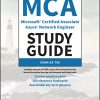
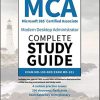

![Mike Meyers CompTIA Security+ Certification Passport (Exam SY0-601) 6th Edition Dawn Dunkerley [Dawn Dunkerley]](https://ebookmeta.com/wp-content/uploads/2024/05/mike-meyers-comptia-security-certification-passport-exam-sy0601-30355244-247x296.jpg)
